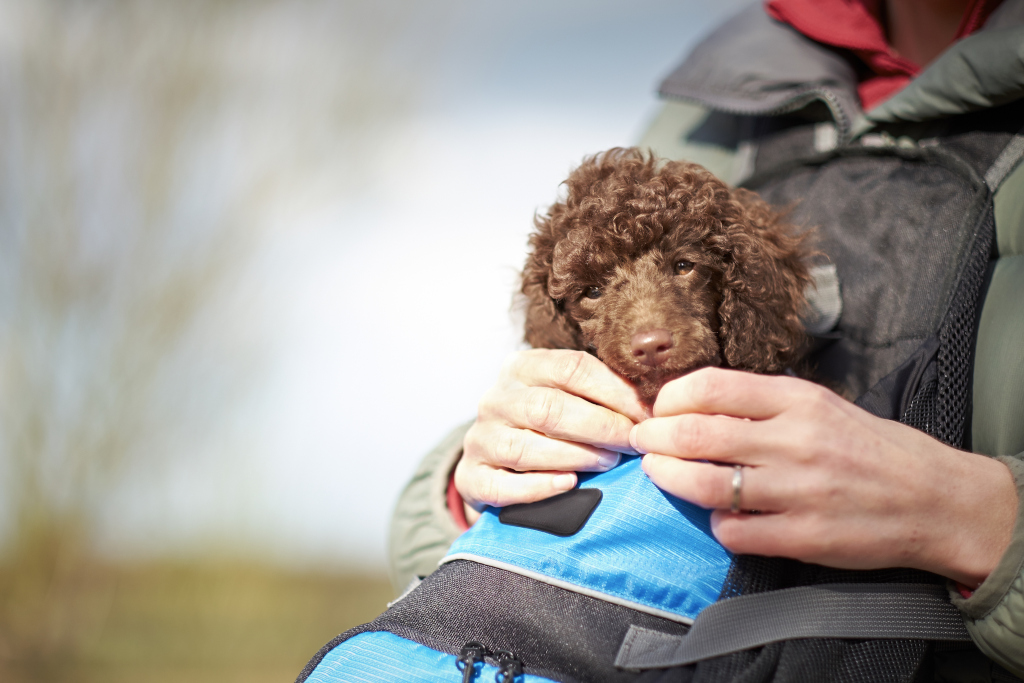When hiking with your dog, there will be that moment when you notice something isn’t right. Your pup limps or whimpers and is too hurt or weak to walk on its own. Then, you find yourself thinking, “how do I carry my injured dog?”
In fact, carrying an injured pet is never an easy task.
Fortunately, there are three ways to carry your dog while on a hiking trail.
There isn’t one best way to do this, and it’s crucial to choose the method that best suits you and your canine companion.
1. Pet Carrier Backpack

One of the easiest ways to carry an injured dog on a hiking trail is by using a pet carrier backpack, although most packs are designed to accommodate small- and medium-size dogs only.
These packs come in two main types, either with a front-facing or a back-facing carrier.
Just as its name suggests, the front-facing carrier will be strapped over the front of your body, giving you the ability to see and interact with your dog. However, it will make it more difficult for you to hike, especially when going uphill or downhill.
On the other hand, the back-facing carrier allows you to carry your canine on your back, similar to a typical backpack. This will give you better balance and stability. The only problem with back-facing carriers is that you can’t see your pup, and you won’t be able to interact with them since they will be resting on your back.
Regardless of which version you get, the pack you choose should have ample padding for comfort and safety. Plus, it must be sturdy enough to support your dog’s weight and have proper air circulation.
2. Rescue Harness
Another way to carry your dog on a hiking trail is by using a rescue harness, also called an emergency dog carrying harness.
They are a must-bring gear by hikers and backpackers who frequently go on long hikes or mountaineering. These basically wrap around your dog’s body, with four sturdy loops to place your dog’s front and hind legs into, and have shoulder straps that make it easier for you to lift and carry your pup on a hiking trail.
The Rock-N-Rescue Dog Harness is one of the most popular ones on the market. Made especially for Search and Rescue K9s, it offers a perfect way to safely move or hoist your canine into any situation.
3. Over-the-Shoulders

An easy way and requires less preparation than the methods mentioned above to transport an injured dog is to throw them over your shoulders, like carrying a sack or using a fireman’s lift technique.
This method requires a good amount of upper body strength and the ability to lift a few extra pounds, especially if your furry hiking companion has significant weight. If you can barely hold up your pup, use this as a last resort.
Note, though, this approach requires some practice as most dogs may freak out the first time and might try to jump off your shoulders. Also, it may only be ideal for short distances since it doesn’t provide the most stability and balance control.
While it is probably not the best option to use during a hike, this technique could be your dog’s only chance of survival in an emergency.
Conclusion
Knowing how to carry an injured dog is essential when you’re in the wilderness.
To sum it up, there are three methods to carry an injured dog on a hiking trail. That is to either use a pet carrier backpack, a rescue harness, or an over-the-shoulder technique.
In any case, make sure you have the necessary gear, including a first-aid kit, hiking harness, leash, as well as enough food and a dog travel water bottle when going hiking with your four-legged friend.
Lastly, always equip yourself with knowledge about potential hazards that could harm or hurt either of you and how to avoid them at all costs.
Happy trails!

